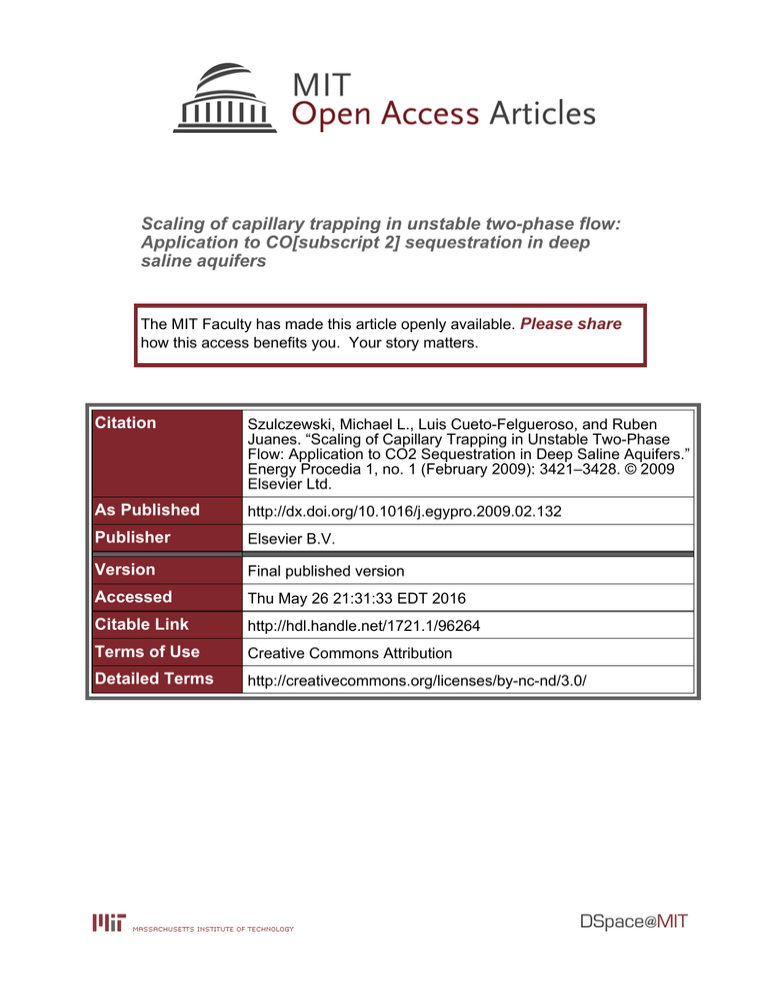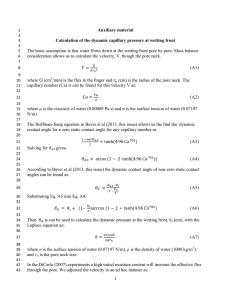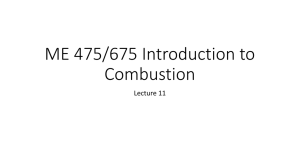
Scaling of capillary trapping in unstable two-phase flow:
Application to CO[subscript 2] sequestration in deep
saline aquifers
The MIT Faculty has made this article openly available. Please share
how this access benefits you. Your story matters.
Citation
Szulczewski, Michael L., Luis Cueto-Felgueroso, and Ruben
Juanes. “Scaling of Capillary Trapping in Unstable Two-Phase
Flow: Application to CO2 Sequestration in Deep Saline Aquifers.”
Energy Procedia 1, no. 1 (February 2009): 3421–3428. © 2009
Elsevier Ltd.
As Published
http://dx.doi.org/10.1016/j.egypro.2009.02.132
Publisher
Elsevier B.V.
Version
Final published version
Accessed
Thu May 26 21:31:33 EDT 2016
Citable Link
http://hdl.handle.net/1721.1/96264
Terms of Use
Creative Commons Attribution
Detailed Terms
http://creativecommons.org/licenses/by-nc-nd/3.0/
Available online at www.sciencedirect.com
Energy
Procedia
EnergyProcedia
Procedia1 00
(2008)3421–3428
000–000
Energy
(2009)
www.elsevier.com/locate/procedia
www.elsevier.com/locate/XXX
GHGT-9
Scaling of capillary trapping in unstable two-phase flow:
Application to CO2 sequestration in deep saline aquifers
Michael L. Szulczewski, Luis Cueto-Felgueroso, Ruben Juanes*
Massachusetts Institute of Technology. 77 Massachusetts Avenue, Cambridge, MA 02139, USA
Elsevier use only: Received date here; revised date here; accepted date here
Abstract
The effect of flow instabilities on capillary trapping mechanisms is a major source of uncertainty in CO2 sequestration in deep
saline aquifers. Standard macroscopic models of multiphase flow in porous media are unable to explain and quantitatively predict
the onset and structure of viscous-unstable flows, such as the displacement of brine by the injected CO2. We present the first step
of a research effort aimed at the experimental characterization and mathematical (continuum) modeling of such flows. Existing
continuum models of multiphase flow are unable to explain why preferential flow (fingering) occurs during infiltration into
homogeneous, dry soil. We present a macroscopic model that reproduces the experimentally observed features of fingered flows.
The proposed model is derived using a phase-field methodology and does not introduce new independent parameters. From a
linear stability analysis, we predict that finger velocity and finger width both increase with infiltration rate, and the predictions
are in quantitative agreement with experiments.
©
c 2008
2009 Elsevier
Elsevier Ltd.
Ltd. All
All rights
rights reserved
reserved.
Keywords: multiphase flow; CO2 sequestration; capillary trapping; gravity fingering; phase-field modeling.
1. Introduction
One of the major concerns in any sequestration project is the potential leakage of the CO2 into the atmosphere.
Because the CO2 is less dense than brine, it tends to migrate upwards to the top of the geologic structure. The
success of a sequestration project depends heavily on the mechanism of capillary trapping, by which the CO2 phase
is disconnected into an immobile (trapped) fraction. The application of the present paper is, specifically, the
prediction of capillary trapping in geological CO2 storage projects at the field scale.
We investigate, by means of laboratory experiments, the dependence of capillary trapping on the flow dynamics
and, in particular, on the instability of the injected CO2 plume. Factors that contribute to flow instability (and,
thereby, reduced storage efficiency) are viscous fingering, permeability channeling, and gravity override. Here we
report the results of laboratory experiments of unstable fluid displacements in a transparent glass-bead pack, which
enables simple visualization techniques to monitor the flow. We perform drainage of a low-viscosity fluid followed
* Corresponding author. Tel.: +0-000-000-0000 ; fax: +0-000-000-0000 .
E-mail address: juanes@mit.edu.
doi:10.1016/j.egypro.2009.02.132
3422
M.L. Szulczewski et al. / Energy Procedia 1 (2009) 3421–3428
M. L. Szulczewski et al. / Energy Procedia 00 (2008) 000–000
by imbibition, at different viscosity ratios, flow rates and tilt angle that span the range of conditions found in
geologic CO2 storage.
The experimental observations and high-resolution numerical simulations can be summarized as follows: the
effectiveness of capillary trapping decreases with increasing “disorder” of the injected CO2 plume. We show that the
residual nonwetting-phase saturation measured from core floods is not representative of the average values attained
in multidimensional, large-scale flows. We confirm that current field-scale simulation models of CO2 storage
overestimate the amount that is actually trapped, because they do not capture the subgrid variability (“disorder”) due
to viscous and gravity instabilities, and permeability channeling. The main result of the paper is a correlation
between an effective trapping coefficient and storage efficiency.
It is fair to say that current formulations of multiphase flow through porous media are incorrect or, at best,
incomplete. All models are based on a straightforward extension of Darcy’s law to several flow fluid phases. Such
models simply cannot capture some of the essential behavior of fluid-fluid displacement in porous media. Examples
of behavior observed in physical experiments and that current models cannot reproduce are: (1) viscous fingering
during the injection of a less viscous fluid (water, gas, or solvent) into a more viscous fluid (oil); (2) gravity
fingering during oil recovery by gravity drainage. In Figure 3 we show a sequence of two displacements performed
in our lab: first drainage, followed by imbibition. The prediction of the residual oil saturation is heavily dependent
on the pattern of the initial invasion of the fluid.
Non-wetting phase
Injection of the
nonwetting phase
Injection of the
wetting phase
Wetting phase
Trapped
nonwetting
phase
Fig. 1 Unstable displacement of a wetting fluid by a less viscous, non-wetting fluid (drainage), followed by imbibition. These
results illustrate the complexity of instable displacements in multiphase flor in porous media, and the dependence of the residual oil
saturation on the displacement pattern of the initial drainage displacement.
M.L. Szulczewski et al. / Energy Procedia 1 (2009) 3421–3428
3423
M. L. Szulczewski et al. / Energy Procedia 00 (2008) 000–000
Fig. 2 Numerical simulation of a viscous-unstable displacement using the standard macroscopic theory of flow in porous
media. Maps of water saturation at breakthrough time. (A) Mobility ratio M= 20, and (B) Mobility ratio M= 50.
2. A phase-field model of unsaturated flow through porous media
Existing continuum models of multiphase flow in porous media are unable to explain why preferential flow
(fingering) occurs during infiltration into homogeneous, dry soil. Fingering patterns have been consistently observed
in laboratory and field experiments for nearly half a century [1,2]. Fingering leads to smaller residence times of
contaminants in soil, may play an important role in soil weathering at the time scale of millennia [3], and it may be
crucial to the impact of water dropout on the operational efficiency of polymer electrolyte fuel cells [4].
Despite the frequent occurrence of gravity fingers in unsaturated media, the explanation, modeling and prediction
of fingered flows with continuum (macroscopic) mathematical models has remained elusive. Many authors have
approached the wetting front instability by drawing an analogy with the two-fluid system in a Hele–Shaw cell [5],
and their analyses have led to kinematic models that reproduce trends observed in the experiments, such as relations
between finger width and finger tip velocity with the flow rate through the finger [2,6-9]. Simulation of unstable
gravity flows has also been performed with modified invasion-percolation models at the pore scale [10,11].
By contrast, conservation laws that model the evolution of water saturation (that is, the locally-averaged
fraction of pore space occupied by water) have been, so far, unable to model gravity fingering successfully. The
traditional model of unsaturated flow, known as Richards equation [12], is a mass balance equation in which the
water flux is modeled by a straightforward extension of Darcy’s law to unsaturated media. It accounts for gravity,
capillarity, and the fact that the permeability to water is reduced because the porous medium is only partially
saturated with water. It is well known that Richards equation leads to monotonic saturation profiles and cannot
predict or simulate fingering under any conditions [13].
To remedy this behavior, several extensions to Richards equation have been proposed. These include a
formulation with dynamic capillary pressure [14,13], designed to account for additional terms that arise from
averaging of the microscopic multiphase flow equations. A related model [15] contains a hypodiffusive term,
introduced to mimic the observed hold-back–pile-up effect, which gives rise to a saturation overshoot at the wetting
front—a distinctive feature of fingered flows. Higher-order terms are required, however, to regularize the
mathematical problem [16]. Here, we propose a physical mechanism and a subsequent continuum mathematical
model that explain why gravity fingers occur during infiltration, and predict when and how they will grow.
3424
M.L. Szulczewski et al. / Energy Procedia 1 (2009) 3421–3428
M. L. Szulczewski et al. / Energy Procedia 00 (2008) 000–000
Fig. 3 Schematic of vertical infiltration of water into a
porous medium. Initially, the soil is almost dry (water
). A constant and uniformly distributed flux of
saturation
(
) infiltrates into the soil. The flux of
water
water is less than the hydraulic conductivity of the soil,
,
.
so that the flux ratio
Macroscopically, a diffuse interface (the wetting front)
moves downwards. This interface is often unstable and takes
the form of long and narrow fingers that travel faster than
the base of the wetting front (see, e.g., Fig. 2 in
(glass1989b)). Microscopically, a sharp interface between
water and air exists (see inset), which is locally governed by
capillary effects.
Consider constant flux infiltration into a porous medium (Fig. 3). It is assumed that the initial water saturation
is uniform, and that the infiltration rate
is uniformly distributed and constant in time. The spatial coordinate
points downwards, in the direction of gravity (acceleration ). The water density and dynamic viscosity are and .
The relevant (macroscopic) parameters concerning the porous medium are its intrinsic permeability , and its
porosity . The permeability of the medium is often expressed as a saturated hydraulic conductivity,
,
which equals the gravity driven flux under full saturation. Hence, the infiltration rate
may be expressed as a flux
ratio,
, with
. When this idealized flow scenario is simulated experimentally, the stability
of the wetting front seems to be controlled by the flux ratio, initial saturation and material nonlinearity [15]. A
saturation overshoot is observed at the tip of the fingers, which grow as traveling waves, advancing with constant
velocity [17]. The formation of fingers appears as a winner-takes-all process, by which the fastest growing fingers in
the initial unstable front channelize most of the infiltrating fluid and inhibit the growth of other incipient fingers
[2,17]. The initial moisture content plays a critical role in the fingering instability: even relatively low saturations
lead to a compact, downward moving wetting front [18]. Stable fronts are also observed in dry media when the
infiltration rate is either very small or approaches the saturated conductivity. In general, larger infiltration rates
produce faster, thicker fingers [2].
Our mathematical model for the water saturation
quantities, takes the form:
during infiltration, when expressed in dimensionless
(1)
where
and
are two dimensionless groups. Our model is similar to that describing the flow of thin films
[19,20], and to phase-field models of epitaxial growth of surfaces and binary transitions [21,22]. The traditional
Richards equation can be recovered by neglecting the nonlocal energy term in Eq. (1). We define the saturationand the dimensionless capillary pressure
. The functional
dependent relative permeability
forms of these constitutive relations are chosen to fit experimental data from quasi-static experiments. In the
following, we adopt the van Genuchten–Mualem model [23],
M.L. Szulczewski et al. / Energy Procedia 1 (2009) 3421–3428
3425
M. L. Szulczewski et al. / Energy Procedia 00 (2008) 000–000
Fig. 4 Saturation maps from the numerical
simulations of Eq. (1), for different values of the
, flux ratio
, and initial
gravity number
. Increasing the gravity number ((A)
saturation
and (B)) changes the scale of the problem but not the
nonlinear dynamics of the wetting front. Large initial
saturations (C) lead to a compact invasion, and small
flux ratios (D) produce thinner, slower fingers in
sufficiently dry media. The flow dynamics and the
distinctive saturation overshoot at the tip of the
fingers, which behave as traveling waves, agree with
experimental observations.
(2)
where
. This model introduces two intrinsic material parameters: and . The dimension of is
, and
is approximately the capillary rise. The nonlinearity of the material is determined by , which
depends on how well-sorted the porous medium is. The gravity number
is defined as
, where is an
arbitrary length scale used to nondimensionalize the equations. The dependence of the capillary rise on the system
, where is the surface tension
parameters is given by the Leverett scaling
between the fluids, and is the contact angle between the air–water interface and the solid surface [24].
Dimensional analysis leads to the scalings
and
, which simply reflect that the solution
should be independent of the choice of the reference lengthscale . In principle, one might postulate the dependence
of
on an additional intrinsic property of the system. Since the idea of a nonlocal interface is fundamentally a
macroscopic construct, it is more rigorous to express
in terms of the already considered basic parameters, and
thus arrive at the scaling
. The coefficient linking
and
must be a constant, and simple
analysis suggests that its magnitude is of the order of one. Therefore, we propose the relation
(3)
sets the intrinsic scale of the problem, and the proposed model
As a consequence of Eq. (3), the gravity number
contains a new term, but not a new independent parameter. The numerical solutions to Eq. (1) capture the
3426
M.L. Szulczewski et al. / Energy Procedia 1 (2009) 3421–3428
M. L. Szulczewski et al. / Energy Procedia 00 (2008) 000–000
experimentally observed features of preferential flow and wetting front instability (Fig. 4). The most salient
qualitative discrepancy between the numerical simulations and the experimental visualizations is the absence of
meandering of the fingers, which is due to small heterogeneities and packing irregularities that always exist in the
experiments and are not considered in the simulations. Our model permits investigation of the dependence of the
flow characteristics with the various system parameters, and predicts the existence of a saturation ridge along the
finger root front, which should be analyzed in future experiments.
The linear stability analysis of Eq. (1) provides further insight into the role of the system parameters on the
dynamics of the flow. Stability refers here to the growth or decay of planar infinitesimal perturbations to the
traveling wave solutions to Eq. (1). We distinguish between asymptotic (modal) and transient (non-modal) growth
behavior, the latter arising from the non-normality of the linearized flow operator [25,20]. For each set of
of the most unstable mode, as well as its associated asymptotic
parameters, we determine the frequency
growth factor
and the transient growth behavior. Positive values of
or intense transient growth are
indicative of an unstable wetting front, and their magnitudes correlate with the severity of fingering.
When the dimensionless groups
and
are considered independent, there is a narrow region in the parameter
–
where
(Fig. 5(A)) and
(Fig. 5(B)) decay exponentially. This region of abrupt decay marks
space
the effective transition from a compact infiltration front to fingering instability, and follows a straight line (in
. The specific location of the transition (not its slope) is determined by the system
logarithmic scale) of slope
parameters ,
and . This critical region cannot be crossed when
moves along
, and therefore
changes in the gravity number do not induce regime transition.
Fig. 5 Results of the linear stability analysis of
Eq.(1). (A)–(B) Contours of the logarithm of the
frequency
of the most unstable mode and its
, as functions of the
associated growth factor
and
. We
dimensionless groups
,
and
. A
set
narrow region of exponential decay, along a straight
, marks the effective transition from
line of slope
stable to unstable flow. The position of this transition
,
and .
region, not its slope, is determined by
Under the proposed scaling
, the
transition region cannot be crossed by modifying
alone. (C) Exponential decay of the scale-invariant
with
the
initial
frequencies
. For a given
, the frequencies
saturation
increase with decreasing
, up to a critical flux
decreases
again.
beyond
which
(D) Exponential decay of the scale invariant growth
with the initial saturation
.
factor
Within the unsaturated regime, the growth factors
The stability analysis also reveals that, under the scaling
,
and
are linear functions
. The scale-invariant frequencies and growth factors,
(Fig. 5(C)) and
(Fig. 5(D)), are
of
indicative of the early dynamics of the perturbed flow and the properties of the emerging fingers. The onset of
M.L. Szulczewski et al. / Energy Procedia 1 (2009) 3421–3428
3427
M. L. Szulczewski et al. / Energy Procedia 00 (2008) 000–000
preferential flow paths in the unstable wetting front is more intense for larger flux ratios and smaller initial
saturations. For very dry media the size of the incipient fingers decreases with the flux ratio. In general, however,
for each value of the initial saturation there is a critical flux ratio beyond which smaller fluxes lead to larger finger
sizes (Fig. 5(C)). This nontrivial result shows that it is possible to observe both decrease and increase in finger size
, depending on the particular values of
and . The growth factor and frequency of the most
with decreasing
unstable mode decay exponentially as the initial saturation is increased. This abrupt decay agrees with experimental
observations, which have suggested the existence of critical values of
for the suppression of the instability [18].
A linear stability analysis has applicability, strictly speaking, to incipient perturbation growth. The dominant role
of the fastest growing fingers suggests, however, that the results of a modal analysis may correlate with the
characteristics of the fullýdeveloped fingers. Using dimensional analysis, and assuming that the finger properties
can be determined from the basic system parameters and the dimensionless groups
,
and
, we arrive at
the following expressions for finger tip velocity and finger width :
(4)
where
and
are experimental constants. For initially dry media, the flux ratio has a relatively modest influence
on
(Fig. 5(C)), and therefore Eq. (4) predicts that the finger width roughly scales like
, which is
consistent with experimental observations and scaling theories in porous media [26].
Fig. 6 Average finger tip velocity (A) and finger width (B) versus flux ratio . The circles are the experimental measurements
of Glass et al. [2]. The crosses (joined by straight solid lines) are the values predicted by the linear stability analysis, together with
,
, and a gravity number
based on the height of the experimental chamber.
Eq. (1). We set
The constants in Eq. (4) are estimated as
and
. The predictions based on the linear stability analysis
reproduce the observed increase of finger velocity and finger size with the flux ratio.
To test these predictions, we compare the finger properties given by Eq. (4) with measurements from the
experiments by Glass et al. [2]. They report experiments of infiltration into homogeneous, initially dry, coarse sands,
for different flux ratios. Constant infiltration rates are achieved through the use of a two-layer configuration, with a
tall, coarse-sand layer at the bottom of the chamber, and a thinner, less conductive, fine-sand layer on top.
Comparison of the experimental and predicted finger characteristics (Fig. 6) suggests the choices
and
. The results from the linear stability analysis, together with Eq. (4), not only reproduce the observed
trends in finger velocity (Fig. 6(A)) and finger width (Fig. 6(B)), but also show good quantitative agreement with
the experimental measurements.
3428
M.L. Szulczewski et al. / Energy Procedia 1 (2009) 3421–3428
M. L. Szulczewski et al. / Energy Procedia 00 (2008) 000–000
3. Conclusions
The present study shows that gravity fingering in unsaturated flow can be explained, described and modeled by
means of continuum balance laws. The success of this simple model to explain infiltration fingers suggests that
similar continuum models, derived using the framework of phase-field modeling, may improve our ability to predict
unstable multiphase flow in porous media.
Acknowledgements
We gratefully acknowledge funding for this research, provided by Eni under the Multiscale Reservoir Science
project, and by the Winslow Career Development Chair.
References
1.
2.
3.
4.
5.
6.
7.
8.
9.
10.
11.
12.
13.
14.
15.
16.
17.
18.
19.
20.
21.
22.
23.
24.
25.
26.
D. E. Hill and J.-Y. Parlange, Soil Sci. Soc. Am. J. 36, (1972) 397.
R. J. Glass, J.-Y. Parlange, and T. S. Steenhuis, Water Resour. Res. 25, (1989) 1195.
D. Markewitz, E. A. Davidson, R. Figueiredo, R. L. Victoria, and A. V. Krusche, Nature 410, (2001) 802.
C. Y. Wang, Chem. Rev. 104, (2004) 4727.
P. G. Saffman and G. I. Taylor, Proc. R. Soc. Lond. 245, (1958) 312.
R. L. Chuoke, P. van Meurs, and C. van der Poel, Petrol. Trans. Am. Inst. Min. Eng. 216, (1959) 188.
J.-Y. Parlange and D. E. Hill, Soil Sci. 122, (1976) 236.
D. A. Weitz, J. P. Stokes, R. C. Ball, and A. P. Kushnick, Phys. Rev. Lett. 59, (1987) 2967.
D. A. DiCarlo and M. J. Blunt, Water Resour. Res. 36, (2000) 2781.
B. Xu, Y. C. Yortsos, and D. Salin, Phys. Rev. E 57, (1998) 739.
B. Berkowitz and R. P. Ewing, Rev. Geophys. 19, (1998) 23.
L. A. Richards, Physics 1, (1931) 318.
J. L. Nieber, R. Z. Dautov, A. G. Egorov, and A. Y. Sheshukov, Transp. Porous Media 58, (2005) 147.
S. M. Hassanizadeh and W. G. Gray, Water Resour. Res. 29, (1993) 3389.
M. Eliassi and R. J. Glass,Water Resour. Res. 38, (2002) 1234.
D. A. DiCarlo, R. Juanes, T. LaForce, and T. P. Witelski, Water Resour. Res. 44, (2008) W02406.
J. S. Selker, J.-Y. Parlange, and T. Steenhuis,Water Resour. Res. 28, (1992) 2523.
T. X. Lu, J. W. Biggar, and D. R. Nielsen, Water Resour. Res. 30, (1994) 3283.
H. E. Huppert, Nature 300, (1982) 427.
A. L. Bertozzi and M. P. Brenner, Phys. Fluids 9, (1997) 530.
M. Dub´e, M. Rost, K. R. Elder, M. Alava, S. Majaniemi, and T. Ala-Nissila, Phys. Rev. Lett. 83, (1999) 1628.
H. Emmerich, Adv. Phys. 57, (2008) 1.
M. T. van Genuchten, Soil Sci. Soc. Am. J. 44, (1980) 892.
P. G. de Gennes, Rev. Mod. Phys. 57, (1985) 827.
L. N. Trefethen, A. E. Trefethen, S. C. Reddy, and T. A. Driscoll, Science 261, (1993) 578.
J. S. Selker and M. H. Schroth, Water Resour. Res. 34, (1998) 1935.









